Kona gives Hyundai high-caffeine CUV
By John Gilbert
DETROIT, Michigan
Driving in Northern Minnesota requires extra diligence because of the long winters and severe ice and snow circumstances, and while moving toward all-wheel-drive has led to enormous growth of Sport Utility Vehicles segment with AWD, the new preference seems to be for the smallest possible vehicle with the attributes of larger SUVs.
Actually, that’s where my wife, Joan, and I are at in considering a new vehicle for the wilds of the North Shore near Duluth, MN. It is difficult to make a decision, however, among the many exceptional small crossovers. And now, bursting upon the scene, is the Hyundai Kona, which meets just about every requirement we have on our list of “finalists.”
Not the least of Kona’s assets is that I attained 33.5 miles per gallon with the optional turbo engine while negotiating the all-terrain roads of suburban Detroit.
If you think you’re keeping up to date on the auto industry, you’re aware how rapidly SUVs are taking over, and how rapidly compact SUVs are going past midsize SUVs. However, while we weren’t paying close attention, something called “subcompact CUVs” were growing faster than even the compact SUVs in the marketplace.
While cars of all sizes suffered in the highly competitive market over the last year, midsize SUVs grew by 9.4 percent in sales. Compact SUVs — the popular gang that includes the Honda CR-V, Toyota RAV4, Nissan Rogue, Mazda CX-5, Jeep Compass, Ford Escape and others — grew 1.7 percent. Meanwhile, Subcompact CUVs grew at a 4 percent clip, more than twice as fast as compacts.
That Subcompact CUV group, Hyundai, suggests, includes the Chevrolet Trax, Honda HR-V, Toyota C-HR, Mazda CX-3, Jeep Renegade, Subaru Crosstrek, Ford EcoSport, and Nissan Kicks, and is projected to grow another 16 percent this yearit is that segment that Hyundai has aimed the Kona.
Named after Hawaii’s elite coffee, the Kona drives similar to how a swig of Kona’s caffeine might give you a quick uplift. Its looks are, in a word, quirky but unobtrusive. Contemporary in its collection of accent lines, contours and grooves, the Kona comes in four varieties, which are the base SE, the SEL, the Limited, and the Ultimate, ranging in price from just a shade under $20,000 to loaded form right up there at $30,000.
Before we get behind the wheel, those choices are intriguing, because you can get all-wheel drive up and beyond the standard front-wheel drive on all four models. You also get a choice of impressive technology, beginning with a totally new vehicle with the enhanced structural rigidity of a body made out of 52 percent high-strength steel, which also requires the notification that Hyundai is the only auto-maker that owns its own steel plant. Along with the rigidity to aid handling stability, that assures top marks from every structural safety measurement.
The compact exterior retains Hyundai’s latest “signature” cascading grille of horizontal bars, although it is notable at a glance because the grille is surrounded by foglights down below, the normal light enclosure with its daytime running lights and turn signals on either side, and stylish horizontal slits at the top leading edge of the front fenders for the headlights.
With body protection outlineing the wheelwells, the Kona looks ready for a bit of mile off-roading, even though buyers undoubtedly won’t confront much beyond the northern-climate potholes. Kona looks stylish, and will fit in well in Hyundai’s array of SUVs, from the top Santa Fe, to the shorter Santa Fe Sport, and the compact Tucson. All of them represent a considerable bargain in the auto market, and the Kona will be the latest example.
Growing families with two or three kids might find the Kona too confining and move up to a larger vehicle, but for those whose kids have flown the coop and who don’t regularly carry rear seat occupants, the need for spacious front buckets and only occasional rear seating should check out the Kona. On our regional test-drive around Detroit, we checked out the rear seat and found that it was only tight getting in and out, and once in, headroom is plentiful and knee and leg room can be negotiated with front-seat occupants. That’s what you expect in the subcompact class, and with a length of 164.9 inches and wheelbase of 102.4, the Kona fits the standard.
With a 6.7-inch ground clearance, the Kona has 19.2 cubic feet of cargo space, and only the HR-V and Crosstrek can top that. Ride comfort and smooth operation is evident every time you drive the Kona, and the only concession to any jolts might be due to the optional wheel size, which grow by the model, thus reducing the aspect ratio that makes lower-profile tires fit with their inherent less cushioning.
When it comes to driving, the Kona is quick and agile, with the base engine a 2.0-liter 4-cylinder “Nu” engine with Atkinson cycle ability to hold the valves open for longer duration of the combustion stroke for better efficiency, power and fuel economy. The 2.0 has EPA estimates of 147 horsepower at 5,500 RPMs, and 132 foot-pounds of torque at 4,500 RPMs.
For the day, my co-driver and I drove the Kona Ultimate, with the optional all-wheel drive powered easily by the smaller, but more potent, 1.6-liter 4-cylinder “Gamma” engine, which is turbocharged to kick out 175 horsepower at 5,500 RPMs, and sustain a torque peak of 195 foot-pounds of torque from 1,500-4,500 RPMs. That means if you stand on it, even moderately, torque rises to its peak at just a tick above idle speed, and stays there until you range up approaching red-line.
The extra punch of the turbo 1.6 doesn’t flinch from the added requirements of the all-wheel drive system in the Kona, and Hyundai, which made its breakthrough-technology 2.4-liter engine in 2010 for the Sonata, has not only expanded its technique to all its engines, but also started building its own transmissions.
Its 6-speed automatic is smooth and efficient, and operates with the 2.0 engine, and Hyundai’s high-tech 1.6 has the added quick-shifting and flexibility of its newer 7-speed dual-clutch transmission, which switches clutches as you drive, each clutch operating the next gear in progression.
Handling is fine, with the all-wheel drive versions getting a new multilink rear to replace the beam rear suspension in the FWD Konas. Hyundai has engineered a front-brake operated torque-vectoring system to improve turn-in instincts for more safety, and while the AWD self-regulates the percentage of power from front to rear axles, you can also lock it into la 4×4 system that sends 50-percent front and rear.
For style, the Kona has its own striking pallette of colors. We drove a bright red model Ultimate, and it didn’t have the optional black roof, which is nice enough, but doesn’t always fit, in my estimation. I liked it, on the other hand, with the darkest of the grey paint jobs, where it looked more appropriate.
Interior textures are all modern, too, with soft-touch stuff on the dashboard and door panels. The sound system has an Infinity premium upgrade, and moving higher in model status, you can add forward collision avoidance, lane-keep assist, blind-spot collision assist, rear camera with cross-traffic alert, pedestrian detection, high-beam assist, and even driver-alert assist in case you seem to the car to get a bit drowsy.
Hyundai executives like to say how the company strives to provide luxury and features that are a level up from what buyers might anticipate, and things like a pop-up heads-up display, Blue Link connectivity, remote start and wireless cell phone charging are evidence of that on the Kona.
By the time Konas get out in force to dealerships all over the U.S., it will be time for the fall production start of the Kona EV — for electric vehicle. That will come with a 64-killowatt hour electric system with the equivalent of 201 horsepower and 291 foot-pounds of torque, and, more important than its obvious performance, will have a 250-mile front-wheel drive range and a standard fast-charge system. By then, gasoline might cost $4 a gallon.
For now, though, the new Kona is futuristic enough to require consideration than any consumer who wants a combined SUV and citified runabout with all-season AWD capability.


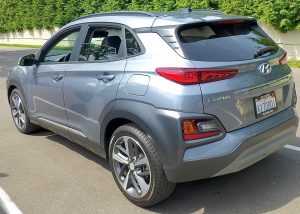
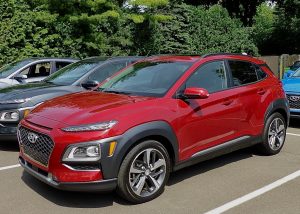
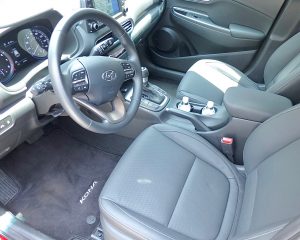
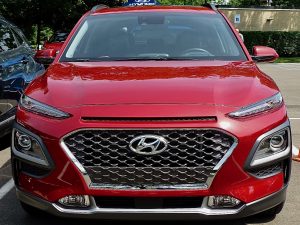
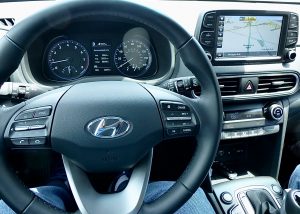
 John Gilbert is a lifetime Minnesotan and career journalist, specializing in cars and sports during and since spending 30 years at the Minneapolis Tribune, now the Star Tribune. More recently, he has continued translating the high-tech world of autos and sharing his passionate insights as a freelance writer/photographer/broadcaster. A member of the prestigious North American Car and Truck of the Year jury since 1993. John can be heard Monday-Friday from 9-11am on 610 KDAL(www.kdal610.com) on the "John Gilbert Show," and writes a column in the Duluth Reader.
John Gilbert is a lifetime Minnesotan and career journalist, specializing in cars and sports during and since spending 30 years at the Minneapolis Tribune, now the Star Tribune. More recently, he has continued translating the high-tech world of autos and sharing his passionate insights as a freelance writer/photographer/broadcaster. A member of the prestigious North American Car and Truck of the Year jury since 1993. John can be heard Monday-Friday from 9-11am on 610 KDAL(www.kdal610.com) on the "John Gilbert Show," and writes a column in the Duluth Reader.